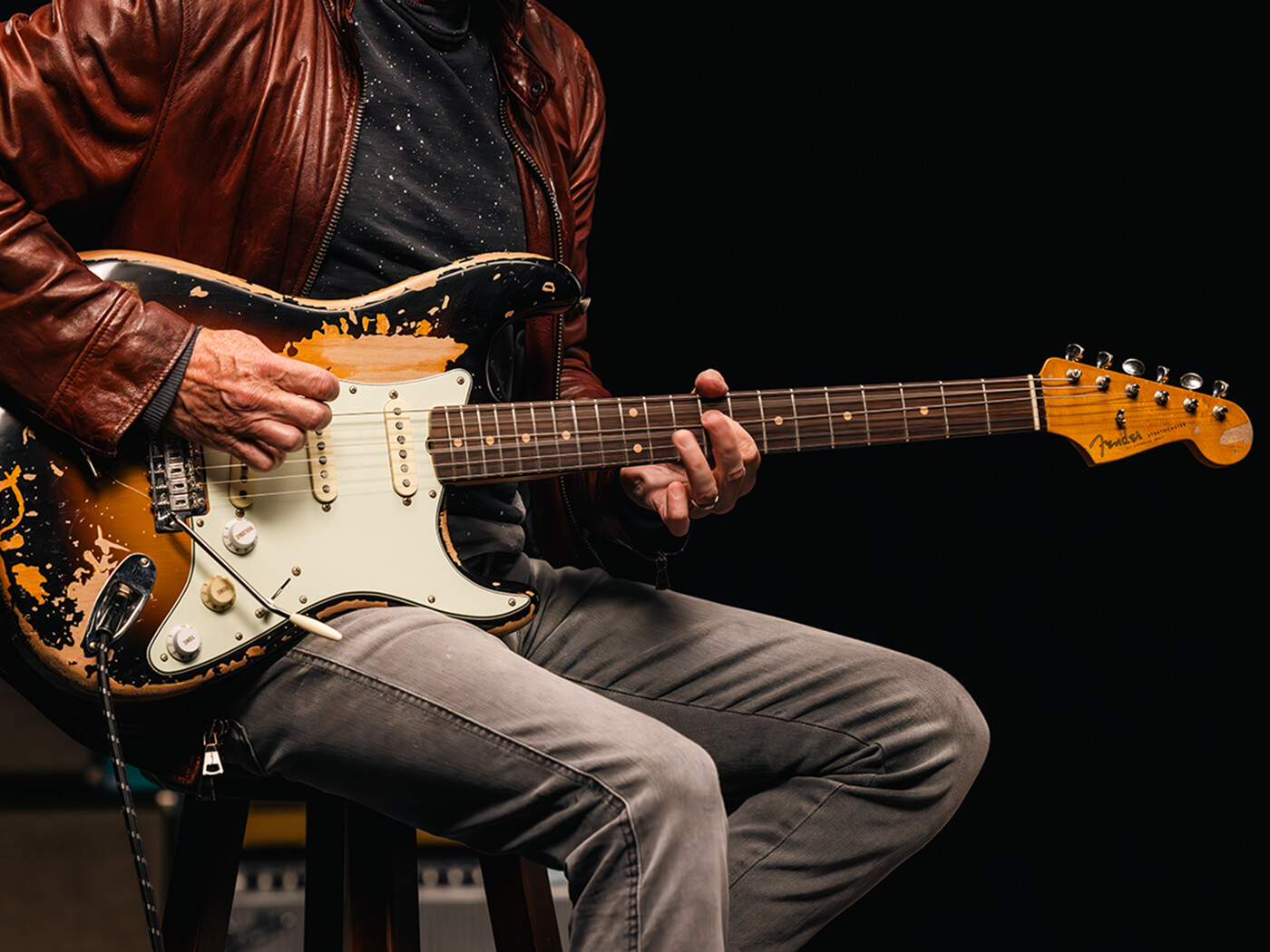Related Tags
“It has to sound as close to the 1960 as it can” Mike McCready on the painstaking process behind his new affordable signature Strat
The Pearl Jam guitarist on why it was important that his new Fender Strat was “perfect”, his long-term love affair with his 1960 Strat, and the importance of trying new things.

Mike McCready playing his signature Fender Stratocaster. Image: Fender
Many, many bands have tried to manufacture a sense of unpredictability, but the reality is that you can’t. You can spot a fake from a mile away, just as it’s also easy to identify the real thing. For more than 30 years, Mike McCready’s playing has been a spiralling, unorthodox seam in Pearl Jam’s flannel world, with his characterful studio work offset by surging live leads and solos seemingly channelled from beyond. When he lets go, head back, eyes closed, that’s the real thing.
- READ MORE: A Brief History of Squier Guitars
“Art and music can be created to bring us together in a communal sense, or in a spiritual sense,” he says. “Guitar, for me, is at its best when it’s doing that. I can’t force that to happen. I want to, but it’s fruitless. When I’m playing with my guys live, with the energy of a crowd, or in the studio when I’m not thinking, that’s when I’m connected to something higher up that’s coming through me. That’s the only way I can describe it.”
McCready is talking over Zoom midway through Pearl Jam’s latest US arena tour, with his mind on the new, more affordable, iteration of his signature Fender Stratocaster, which is modelled after the battle-scarred 1960 guitar that has long served as a lightning rod for these moments of freewheeling creativity. Following in the well-received wake of a very pricey Custom Shop model a few years back, this version recreates its road-worn lacquer alongside a 9.5” slab rosewood fingerboard, a slim C maple neck, a synchronised tremolo, bent-steel saddles, a cold-rolled steel block, and pickups that have been fine-tuned to replicate his tone.
“We’ve spent a lot of time going back and forth with Fender to go, ‘This thing has to be perfect – the neck’s gotta feel this way, the treble pickup has to be not too high-end-y, it has to sound as close to the 1960 as it can,’” he says. “I feel like Fender has done that. On the last tour over in Europe, we had three different models of it. I would move between them and go, ‘I like aspects of this one, but I don’t on this one, the pickups are good on this one, not on this one.’ We put all those together into one Frankenstein guitar.”

Vaughan To Do It
McCready’s relationship with the original instrument began back in 1992, when he came across what he believed to be a ‘59 Strat in Los Angeles (during the making of the Custom Shop model, Fender’s master builder Vincent Van Trigt discovered it to be a ‘60). Inspired by Stevie Ray Vaughan, he pulled it into his rotation just after Pearl Jam made the record that would break them into the grunge stratosphere.
Next to the rapid sprint to ubiquity enjoyed by Nirvana’s Nevermind the band’s 1991 debut LP, Ten, was a marathon runner that spent a couple of hundred weeks on the Billboard chart on its way to selling 13 million copies in the US alone. But as it kept on rolling, McCready was still figuring out exactly what sort of player he wanted to be. The ‘60 entered his life at a time when he was malleable, quickly becoming a part of his creative language in a manner that moved beyond most artist-instrument relationships.
“I was 25 when that record came out,�” he recalls. “I was a giant fan of Stevie Ray Vaughan and Hendrix. I was trying to emulate those guys in a lot of our songs, and as I was trying to emulate them I was coming up with my own style within that. I talked about my early influences all the time in interviews back then. I think that those things got into my playing and it came out me. It took a while to get there, playing a lot of shows, playing with a band, and playing on a lot of records, to create a style.”

By the time work on their second album Vs. began in 1993 the ‘60 was locked in, but very little else was. Pearl Jam responded to the scrutiny and pressure of a hit record by resetting a little, serving up a more abrasive sound that was only completely sure of itself here and there. McCready recalls turning to a 335 for songs such as Animal — aka Even Flow if it hated you and wanted you to know about it — but it’s the tracklist’s next step, Daughter, that shows the developing relationship with his Strat in the best light. An almost supine rocker that plays Eddie Vedder’s vocal intensity off warm acoustics and loping chords, it remains one of Pearl Jam’s finest low-key moments. “I wanted to get that sound of the out-of-phase pickup, the second position, for the rhythm part of it,’” McCready recalls.
On tour right now, he’s playing Daughter with one of the new signature Strats in what is essentially the ultimate road-test, and he’s liking what he hears. “I felt confident that Fender did a lot of due diligence in getting back and forth with me,” McCready says. “George Webb, who works for us, helped me be very specific in picking out what it needed to look like, how the pickups needed to sound. I use it on six or seven or eight different songs on this tour. That’s important to me, because it’s real. It holds up on all those songs. My 1960, the original one, is the best, I’m not gonna say that’s not the case. Nothing’s gonna sound as good as that, but this one’s right next to it.”
Stab In The Dark
The headstock of McCready’s ‘60 famously features a huge gouge resulting from a mis-timed stab at a speaker in the mid-1990s. “I was so into it, I wanted to take a speaker out and I missed, I hit the wood on the side,” he recalls. The dent has been lovingly recreated on each of his signature guitars, like a reminder to keep chaos close at hand. “That’s how I play,” he adds. “I feel like it can be uncontrollable, it can be passionate, it can be exciting, hopefully, at its best. That’s what I want to be as a player, and to be a contributor to our band, as a writer, or supporting someone to write a song. That’s important to me.”

With so much emphasis placed on live performance throughout their career, it’s perhaps inevitable that some of that spiky energy would carry over into experiments such as No Code and Binaural, but it’s something for a band as seasoned as Pearl Jam to still be kicking against the idea of stasis. “We have those conversations – we’re at a situation in our lives now where we can do whatever we want,” McCready says. “So, let’s do whatever we want. There aren’t as many rules as we thought there were in the beginning. We’re less full of anxiety than we were at the beginning.”
Work is ongoing on a new Pearl Jam record – the follow up to 2020’s Gigaton – with producer Andrew Watt, who also helmed Vedder’s 2022 solo record Earthling while playing in his live band. McCready observes that Watt put a good kind of pressure on the band at a time when they could be phoning it in or sleepwalking through the hits on stage.
“I always want to try new things – I used all of his amps, his guitars, his pedals, just because I wanted to be forced to play a different way,” McCready says. “Sometimes that’s, ‘I’ll try that guitar, because it’s an awesome guitar, or ‘I’ll try that pedal because I’ve never heard it, I don’t know what it does.’ As an artist and as a human I want to be open and to experiment, to not just do the same thing over and over again. It’s easier to do it over and over again. I don’t want it to be that way.”

It’s funny, because this attitude also helps to highlight the importance of having an anchor. McCready can get as esoteric as he wants, play a million different guitars, but he’ll likely never get lost. That’s because he knows that when he’s in a bind he can call up the ‘60, which has had his back for decades. These days, he doesn’t have to search for a sound – he knows, instinctively, what it can do, and when he can lean on it in moments of uncertainty. “I will grab it when there’s a song we’re working on and I don’t know what to use,” he says. “I’m like, ‘Shit, I’ll take my Strat and that will help me.’ It’s my go to, it’s my friend, it’s my companion.”
Find out more about the Mike McCready Strat at Fender.com
